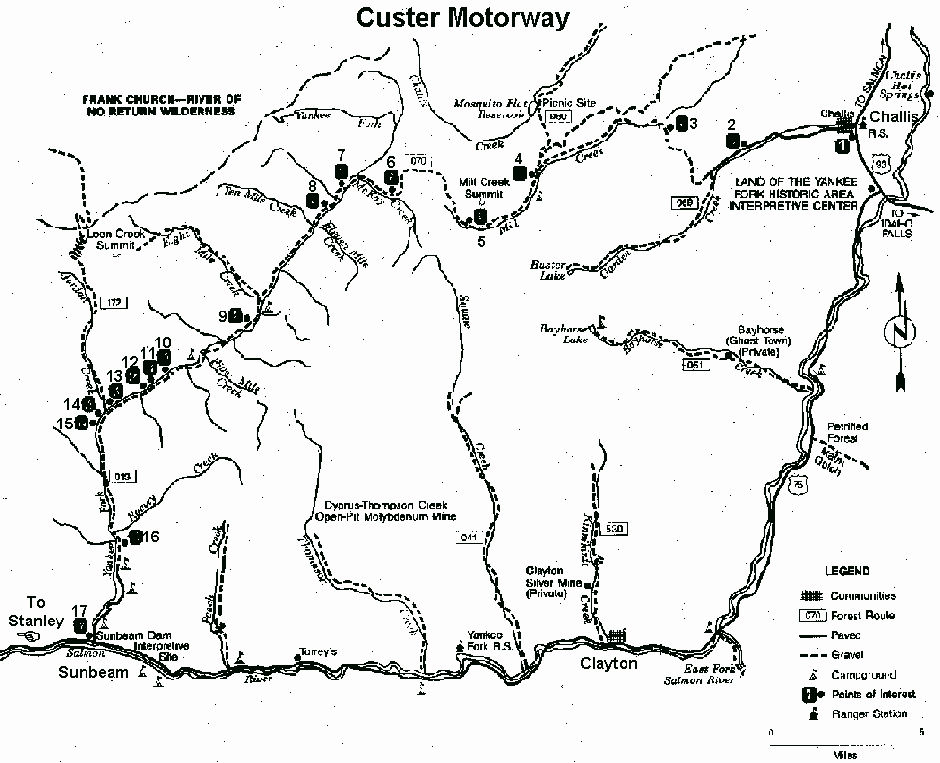
Custer Motorway Map
Adapted from the Custer Motorway Adventure Road brochure developed by the Salmon/Challis National Forest and the Idaho Department of Parks & Recreation. Numbered descriptions below correspond to numbers on the map.
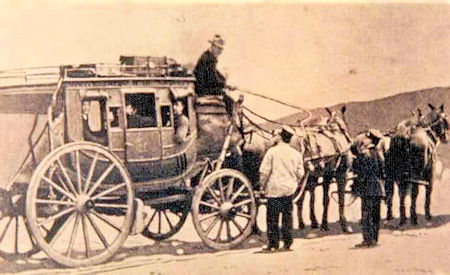
1. Challis
Challis was founded in 1876 as a supply center for the Salmon River area mines, including the Yankee Fork, Bayhorse, and Clayton mining districts. Supplies were brought to Challis by horse-drawn freight wagons from Corinne, Utah, which was on the Union Pacific Railroad.
Each round trip from Challis to Corinne and back to Challis usually took about one month. After the railroad reached Blackfoot, each round trip took about two weeks. At first, supplies for the mines had to be packed by horses or mules from Challis.
With the completion of the toll road in 1879, heavy loads of mining equipment and supplies necessary for large-scale development could be hauled to the mines by oxen or horse-drawn freight wagons.
Toponce and Co. also initiated stagecoach service between the railhead and Challis and between Challis and the Yankee Fork mines on a bi-weekly basis. The 35-mile trip between Challis and Bonanza took about nine hours and cost $8.
2. Cartwright Gulch
At this point, the Challis-Bonanza Toll Road turned north up Cartwight Gulch and continued west to Mill Creek, up to Pine Summit and then back to Mill Creek at Greenwood Station. This is the only major stretch of the toll road not followed by the Custer Motorway.
3. Corkscrew Grade and Slab Barn
On the hill in back of the small ranch visible from this point, is Corkscrew Grade. Here extra teams of horses or oxen were hitched to heavy freight wagons for the hard pull up the steep hill. On top of the hill near a small natural lake was Slab Barn, where stagecoach drivers changed to fresh horses. The small lake is now called Slab Bam Lake.
4. Greenwood Station
A log foundation is all that remains of Greenwood Station which was owned and operated by Fannie Clark. Ms. Clark offered the traveler "comfortable accommodations and a choice bill of fare". The grave of Robert Keene, who died of injuries sustained while breaking a horse in 1889, is 200 yards north of the station in the lodgepole pine forest.
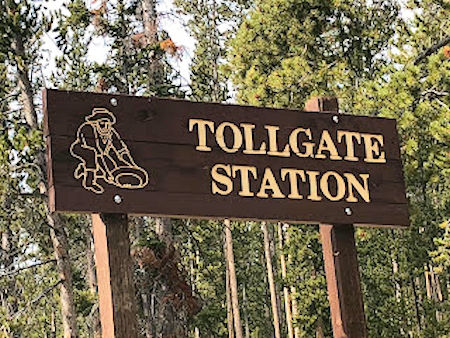
Tollgate Station sign
5. Tollgate Station
The log ruins at this site are the remains of Tollgate Station. Erected by Toponce & Co. in 1879, as the point where tolls were collected for using the road. This station was operated by Chas. & Harriet Keene from 1880 to 1889. The Keenes also provided accommodations for employees of Toponce and offered meals to all travelers. After the station was abandoned by the company in 1889, Fannie Clark relocated her business here.
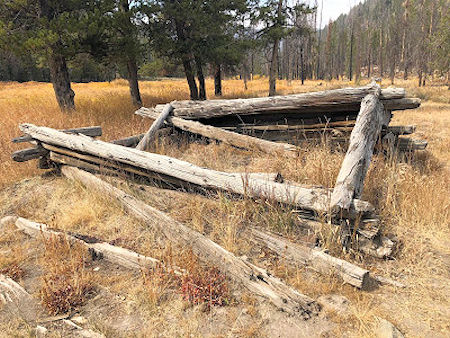
Homestead Station
6. Homestead Station
This lone cabin is all that remains of Homestead Station. This station was owned and operated by James Dwyer. "The public may be confident of a square meal when they patronize this station . . everything kept neat and clean." The cabin was later used as a cowboy line camp.
7. Twelve-Mile Station
Near this spot was Twelve-Mile Station. Daniel McKay purchased the station in 1880, and improved it by building a large two-story hotel and other buildings. "This is one of the most desirable locations on the road and will be an excellent stopping place for both man and beast."
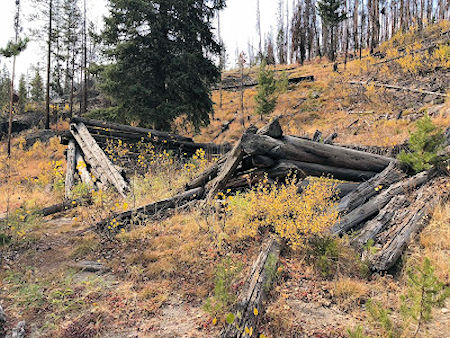
Eleven-Mile Barn
8. Eleven Mile Barn
At this site is the ruins of Eleven-Mile Barn. Here stagecoach drivers could change to fresh horses and passengers could refresh themselves for the run north to Tollgate Station or south to Custer and Bonanza.
9. Yankee Fork Fisheries
During the early summer months, Chinook salmon return from the ocean to spawn in the Yankee Fork. Under treaty rights, members of the Shoshone-Bannock Tribe fish for salmon in much the same manner as their ancestors did hundreds of years ago. Although only tribal members can fish for salmon, fishing for rainbow trout, cutthroat trout, and whitefish is allowed by anyone with a valid fishing license during the fishing season.
While traveling between Eight-Mile Creek and Custer, please drive carefully and watch for vehicles and people fishing.
10. Custer Cemetery
The seven known graves located here are in the Custer Cemetery. Usually most burials were in the Bonanza Cemetery, but when the road to Bonanza was closed because of deep snow or avalanches, burials were made here.
11. General Custer Mill site
Custer Mill. Across the Yankee Fork from this point stood the General Custer Mill. This huge, 30-stamp mill was built in 1880 to process gold ore from the General Custer Mine, and later from the Lucky Boy Mine on Custer Mountain.
With a capacity of 900 tons of ore a month, the mill produced an estimated $8,000,000 in gold between 1880 and 1888 from the General Custer Mine alone. The Lucky Boy owners bought the mill and reopened it in 1895, and soon became the most important producer in the district.
Low ore values and high recovery costs forced closure of the mine in 1904. This signaled the beginning of the end for Custer and Bonanza. Demolished in the 1930's, all that remains of the once proud General Custer Mill is the ore bin on the hillside.
12. Custer City
Founded by Sammy Holman in 1879, Custer was the smaller sister to Bonanza. Unlike Bonanza, Custer was a narrow, one street town which extended for half a mile from the General Custer Mill at the upper end of main street, to China Town at the lower end of the street.
In 1896, Custer eclipsed Bonanza and became the largest of the two towns with a population of 600. With the closing of the last major mine in 1911, Custer virtually became a ghost town.
In 1990, Custer was chosen as the focal point for the Land of the Yankee Fork Historic Area. Stop and take the walking tour of this unique site and visit the many historic displays operated by the Friends of Custer Museum, the Forest Service, and the Idaho Department of Parks and Recreation.
13. Jorden Creek
Sylvester Jordan and Dudley B. Varney located placer gold on this creek in 1870, and called the stream Jordan Creek. This initial find led to discoveries of rich lodes that resulted in the "Rush" to the Yankee Fork.
14. Yankee Fork Gold Dredge
Donated to the USDA Forest Service by J. R. Simplot, the dredge and the dredge tailings are visible reminders of the diverse mining techniques used to extract gold from the Yankee Fork drainage. Stop and let the Yankee Fork Gold Dredge Association give you a tour of this restored floating dredge.
15. Bonanza City
Bonanza City. Bonanza, the first of the two Yankee Fork towns, was established by Charles Franklin in 1877, to serve as the economic and social center of the new mining district. By 1881, the population of Bonanza peaked at 600 and boasted a dentist, a newspaper, a tin shop, a watchmaker, hotels, saloons, boarding houses, a post office, and other specialized businesses.
Although the town had a public well and a water system, major fires in 1889 and 1897 destroyed much of Bonanza. Most merchants then relocated in Custer and after the last large mine closed in 1911, Bonanza became a ghost town. The Civilian Conservation Corps (CCC) established the Bonanza CCC Camp here and built the present guard station in 1934. Drive about one mile west on Forest Road 074 to visit the historic Bonanza Cemetery and Boothill.
Please respect all posted signs while visiting Bonanza.
16. Dredge Tailings
From the mouth of Jordan Creek to near Pole Flat Campground, a distance of 5-½ miles, you will be driving along and through mounds of gravel. These mounds, called "dredge tailings", were left behind as the Yankee Fork dredge moved upstream. Between 1940 and 1952, the dredge "mined" 6,330,000 cubic yards of stream gravels and recovered an estimated $1,037,322.00 in gold and silver.
17. Sunbeam Store and Sunbeam Dam
In 1881, Ebenezer Cunningham, an officer of the Consolidated Yankee Fork Gravel Mining Co., built a small log store at the present site of Sunbeam. In 1910, the Sunbeam Consolidated Gold Mining Co. constructed a dam across the Salmon River to generate electrical power for the Sunbeam Mine on Jordan Creek.
However, the company went bankrupt in 1911, and the power plant was abandoned. In 1934, the rock cliff on the south side of the dam was breached to permit the return of salmon and steelhead to the spawning beds on the upper Salmon River. For more information about the Land of the Yankee Fork, visit the kiosk located at the Sunbeam Dam Interpretive Site.
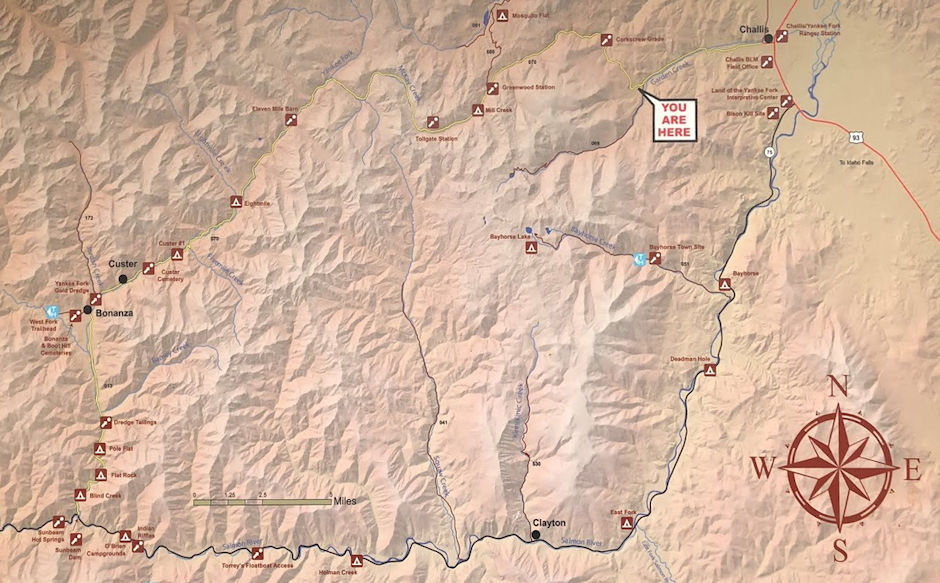
Yankee Fork Historic Area - Custer Motorway